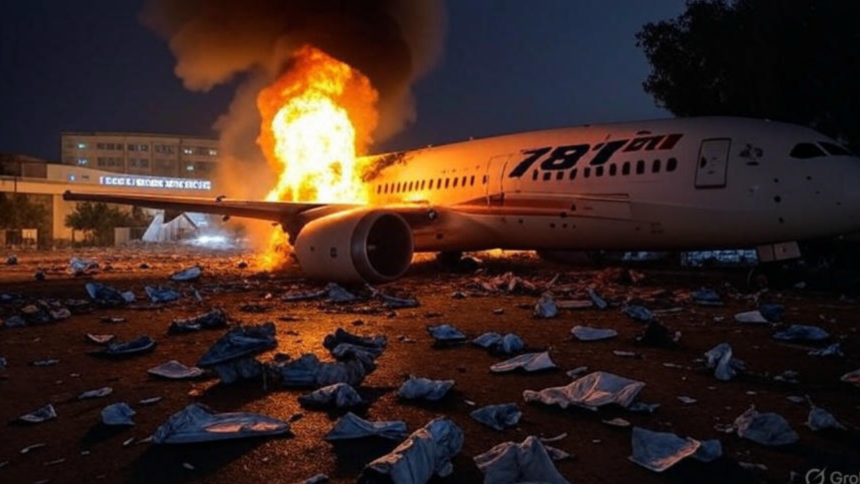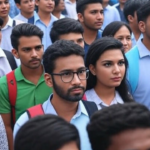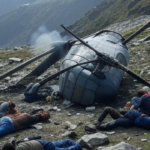On June 12, 2025, Ahmedabad was struck by unimaginable tragedy when Air India Flight AI171, a Boeing 787-8 Dreamliner en route to London, crashed moments after takeoff from Sardar Vallabhbhai Patel International Airport. The plane, carrying 242 souls, plunged into a densely populated neighborhood in Meghaninagar, erupting into a blaze that killed 241 passengers and crew, including former Gujarat Chief Minister Vijay Rupani, and at least 24 people on the ground. Amid the smoldering wreckage, one man, Vishwash Kumar Ramesh, seated in 11A, defied the odds to emerge as the sole survivor, a fact confirmed by Ahmedabad Police Commissioner GS Malik.
Flight AI171 took off at 1:38 p.m., but seconds later, the pilots issued a frantic Mayday call. Witnesses described a chilling roar from the engines before the aircraft plummeted into a hostel at BJ Medical College, home to medical students and doctors. The impact unleashed a fireball, fueled by the plane’s full tanks, reducing much of the site to ash and twisted metal. The death toll was staggering, with five students still unaccounted for, their families left in agonizing limbo.
Vishwash Kumar Ramesh, a 40-year-old British-Indian, was seated in 11A, an economy-class window seat near an emergency exit over the wing. This position proved to be his lifeline. Speaking to the Hindustan Times from Ahmedabad Civil Hospital, where he’s being treated for chest, facial, and foot injuries, Ramesh recalled the chaos: a deafening noise 30 seconds after takeoff, then a terrifying drop. “I thought it was over,” he said, his voice trembling. Yet, in a split-second decision, he unbuckled, spotted a tear in the fuselage, and fled the inferno. Shaky mobile footage captured him staggering toward help, blood-streaked but alive, a sight that left onlookers awestruck.
Experts believe Ramesh’s survival hinged on his seat’s location near the wing box, a robust structural component, and his quick thinking. “He had a narrow window to escape before the fire took over,” said aviation analyst Priya Sharma. “It’s nothing short of a miracle.” Tragically, Ramesh’s brother, Ajay, seated elsewhere, is among the missing, presumed dead. “He kept saying, ‘Find Ajay,’” Ramesh’s brother Nayan told BBC News, highlighting the survivor’s anguish.
The crash, the first fatal incident for a Boeing 787 since its 2011 debut, has sparked a rigorous investigation by India’s Aircraft Accident Investigation Bureau, with Boeing and the U.S. National Transportation Safety Board assisting. The flight data recorder, found atop the hostel’s ruins, offers hope for answers. Early speculation points to engine failure or a critical system fault, but officials urge patience as evidence is analyzed.
The disaster’s ripple effects are profound. Prime Minister Narendra Modi, visibly shaken during a site visit, met Ramesh and vowed support for victims’ families. UK Prime Minister Keir Starmer called the loss “gut-wrenching,” while King Charles sent condolences. Air India, now Tata-owned, pledged ₹1 crore ($120,000) per victim and grounded its 787 fleet for checks. CEO Campbell Wilson called it “a dark day,” committing to transparency.
Ahmedabad is a city in mourning. The crash site, cordoned off, is a grim tableau of scorched earth and shattered lives. DNA testing is underway to identify remains, a painful process for families. The hostel, once a hub of learning, is now a symbol of loss, with tributes of flowers and candles lining its perimeter.
Ramesh’s survival, tied to seat 11A, is a beacon of hope in this darkness. His story resonates globally, a testament to human instinct and luck against overwhelming odds. Yet, it’s bittersweet—his physical escape can’t erase the trauma of losing his brother and witnessing such horror. As the world watches Ahmedabad heal, Ramesh’s tale reminds us of life’s unpredictability and the fragile thread that binds us to survival.





